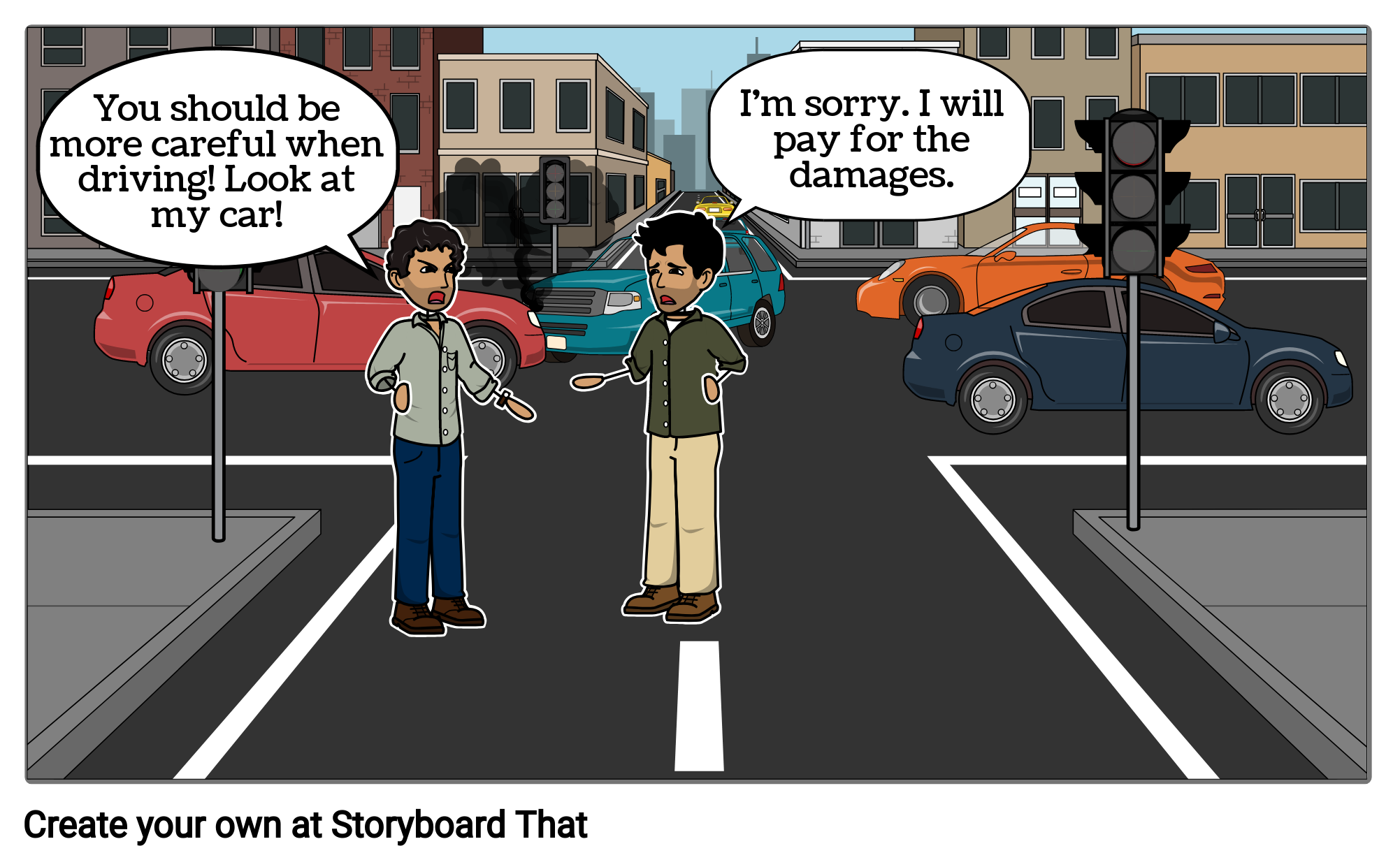LESSON GOAL
Let’s check our lesson goal.
In this material, you will learn the words and phrases that are used when talking about traffic and transportation and express your opinions about specific topics.
In this material, you will learn the words and phrases that are used when talking about traffic and transportation and express your opinions about specific topics.
この教材では、交通と乗り物に関連した語彙や表現を学び、特定の話題について意見を述べる練習をします。
PART A_1
Please study the picture below. Then, describe it in as much detail as you can.
PART A_2

| Answer: | |
| . |
PART A_3
Now, let me ask you a question about the picture.
PART A_4
| 1. | What is the main cause of the accident? |
| Answer: |
PART A_5
Now, let us review your answers.
(Please review your student’s answers by sending the correct answers in complete sentences. After that, ask your student to read aloud his or her corrected answers.)
PART A_6
Choose the correct meaning of the underlined word in each sentence.
PART A_7
| 1. | I want to try traveling by public transport. |
| a. | [noun] a system of vehicles that are used by the public |
| b. | [noun] a section of road where traffic moves slowly |
| c. | [noun] a car with a driver who you pay to take you somewhere |
| 2. | Pedestrians should be careful on the streets to avoid accidents. |
| a. | [noun] a type of road vehicle used especially for carrying goods |
| b. | [adjective] too blocked or crowded |
| c. | [noun] a person crossing the street |
| 3. | My partner was late as she was stuck in a traffic jam for two hours. |
| a. | [noun] a line of vehicles that are moving slowly or not moving at all |
| b. | [verb] to happen in a strong or violent way |
| c. | [noun] a place where roads meet in a circle that drivers go around to find their next road |
| 4. | Everyone should follow the rules and regulations. |
| a. | [verb] reach a destination |
| b. | [noun] policies |
| c. | [noun] a person who is traveling in a vehicle but is not driving it, flying it, or working on it |
| 5. | He was pulled over by the policeman for driving at a red traffic light. |
| a. | [noun] the act of traveling from one place to another |
| b. | [verb] to go across from one side to the other |
| c. | [noun] a set of red, yellow, and green lights for controlling traffic |
PART A_8
Now, let us review your answers.
(Please review your student’s answers by sending the correct answers in complete sentences. After that, ask your student to read aloud his or her corrected answers.)
PART B_1
Please construct your own sentences using the following words.
PART B_2
| 1. | regulation | Answer: | . | |
| 2. | pedestrian | Answer: | . | |
| 3. | traffic jam | Answer: | . | |
| 4. | traffic light | Answer: | . | |
| 5. | public transport | Answer: | . |
PART B_3
Now, let us review your answers.
(Please review your student’s answers by sending the correct answers in complete sentences. After that, ask your student to read aloud his or her corrected answers.)
PART C_1
Please complete each sentence by choosing the correct answer in the box below.
PART C_2
| public transport | traffic jam | pedestrian |
| traffic light | transportation | regulation |
| 1. | Green ____________ means go. |
| 2. | Safety ____________ should not be ignored by drivers. |
| 3. | One of the ____________ was hit by a car. |
| 4. | The accident caused a ____________ for two hours. |
| 5. | There is no ____________ in our area. |
PART C_3
Now, let us review your answers.
(Please review your student’s answers by sending the correct answers in complete sentences. After that, ask your student to read aloud his or her corrected answers.)
PART D_1
Let’s talk. Please answer the questions by stating your opinions.
PART D_2
| 1. | Some people say that private cars are the main reason for traffic jams. What do you think about that? |
| Answer: | |
| 2. | Riding a train is better than driving a car. Do you agree or disagree? |
| Answer: |
PART E_1
Now, I will ask you the following questions. You may ask questions, too.
PART E_2
| 1. | How important do you think it is to use public transportation? |
| Answer: | |
| 2. | What do you think will happen if there is no public transportation? |
| Answer: | |
| 3. | Do you often ride public transportation during rush hour? Why or why not? |
| Answer: | |
| 4. | What do you think is the best way to avoid traffic jams? |
| Answer: | |
| 5. | Have you ever been involved in a traffic accident? |
| Answer: | |
| 6. | What do you think are the main causes of traffic accidents? |
| Answer: | |
| 7. | How will traffic accidents be prevented? |
| Answer: |
REVIEW AND FEEDBACK
Now, let us review the things that you learned in this lesson.
ではこのレッスンで学んだことを振り返りましょう。
(Please give a short feedback on how your student did on your class.)
| Grammar 文法 |
Pronunciation 発音 | Vocabulary 単語 |
Comprehension 理解 |
|
|---|---|---|---|---|
 GOOD GOOD |
文法の誤りはほとんどなく、完全な文章で話すことができる | ほとんどの単語をはっきりと正しく発音することができる | 習った表現を適切に使うことができる | 文章を理解し、質問に正しく答えることができる |
 FAIR |
文法の誤りはあるが、完全な文章で話すことができる | 発音の練習が必要な言葉がいくつかある | たまにミスはあるが、習った表現を適切に使うことができる | 文章を完全に理解するのは難しく、質問に正しく答えられないときもある |
 POOR |
文章で話すのは難しく、単語だけで話すことができる | 発音の練習が必要である | 習った単語と表現を少しだけ使うことができる | 文章を理解するのは難しく、質問に答えるのは難しい |
レッスン教材に関するアンケートのお願い
レッスン教材の改善・拡充を図ることを目的とし、アンケートを実施しております。
以下のURLからアンケートにお答えいただき、 ご意見・ご要望をお聞かせください。
アンケートはこちら